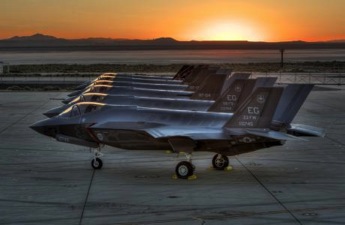Lockheed Martin (NYSE: LMT) investors are looking north his month as Canada decides whether to buy the F-35 stealth fighter, in what would be one of the Canadian military’s biggest investment decisions this decade.
For months, Canadians have debated whether to proceed with plans to buy the F-35 to replace its aging fleet of CF-18 fighters. Last week, Canadian Public Works Minister Diane Finley announced that a decision to proceed (or not) is imminent — and could be announced within just the next few weeks.
Pause and rewind
As recently as 2012, Canada’s path to F-35 deployment looked like it was on autopilot. The country was operating 64 fourth-generation CF-18 fighter jets (the Canadian variant of America’s F/A-18A). It would buy 65 fifth-generation F-35s to replace them — simple as that.
The global economic slowdown, however, and worldwide defense budget crunch that followed it, soon had Canada rethinking the F-35 program’s cost, estimated at $8.3 billion, or close to $128 million per plane. Meanwhile, alternative suppliers of fighter jets — everyone from Boeing (NYSE: BA) to Dassault to BAE Systems (OTC: BAESY) — were queuing up and clamoring that they could sell Canada fighters nearly as good as the F-35, and for a much more attractive cost. And so Canada hit pause on the autopilot, and invited these competing companies to give it more information on their wares.
ALSO READ: Lockheed Martin Defeats Raytheon to Win $915 Million Air Force Contract
Now that the process of considering this information is just about complete, Canada is ready to make a decision — to pick up where it left off with Lockheed Martin two years ago, or to change course.
“Two roads diverged in a wood…”
Which way will Canada ultimately turn? It depends entirely on whether the country considers capability or cost to be paramount.
Last year, in a contest that echoes the one Canada is conducting today, three companies bid to sell South Korea a fleet of 60 new warplanes:
- Lockheed set the bar high with a bid price of $10.8 billion for five-dozen F-35s.
- Eurofighter countered with its Typhoon, at a price tag believed to range from $6.1 billion to $8.1 billion.
- Boeing offered its new F-15SE Silent Eagle at price believed to be below $7.4 billion. (For context, military aviation website Deagel.com has most F/A-18 variants selling for about 10% below the price of the F-15.)
Dassault, apparently deeming its plane either too pricey, or too incapable of competing, did not bid at all.
As you can see, every single offering in the Korean competition undercut Lockheed Martin on price. But at the end of the day, Korea threw caution (and accounting) to the wind — and accepted Lockheed Martin’s offer anyway, for the single reason that it was the only true fifth-generation stealth fighter available.
Fast forward to today, and Canada is faced with a similar choice. Almost certainly, all of the companies hoping to steal pole position from Lockheed Martin in this race will bid low to do it. But if Canada wants a true stealth fighter, this still remains a one-horse race — and Lockheed remains the odds-on favorite to win it.
Top dividend stocks for the next decade
The smartest investors know that dividend stocks simply crush their non-dividend paying counterparts over the long term. That’s beyond dispute. They also know that a well-constructed dividend portfolio creates wealth steadily, while still allowing you to sleep like a baby. Knowing how valuable such a portfolio might be, our top analysts put together a report on a group of high-yielding stocks that should be in any income investor’s portfolio. To see our free report on these stocks, just click here now.
Get Ready To Retire (Sponsored)
Start by taking a quick retirement quiz from SmartAsset that will match you with up to 3 financial advisors that serve your area and beyond in 5 minutes, or less.
Each advisor has been vetted by SmartAsset and is held to a fiduciary standard to act in your best interests.
Here’s how it works:
1. Answer SmartAsset advisor match quiz
2. Review your pre-screened matches at your leisure. Check out the advisors’ profiles.
3. Speak with advisors at no cost to you. Have an introductory call on the phone or introduction in person and choose whom to work with in the future
Thank you for reading! Have some feedback for us?
Contact the 24/7 Wall St. editorial team.





